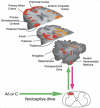Central changes associated with chronic pelvic pain and endometriosis
- PMID: 24920437
- PMCID: PMC4501205
- DOI: 10.1093/humupd/dmu025
Central changes associated with chronic pelvic pain and endometriosis
Abstract
Background: Chronic pelvic pain (CPP) is a significant public health problem with 1 million affected women in the UK. Although many pathologies are associated with CPP, the pain experienced is often disproportionate to the extent of disease identified and frequently no pathology is found (chronic pelvic pain syndrome). The central nervous system (CNS) is central to the experience of pain and chronic pain conditions in general are associated with alterations in both the structure and function of the CNS. This review describes the available evidence for central changes in association with conditions presenting with CPP.
Methods: A detailed literature search was performed to identify relevant papers, however, this is not a systematic review.
Results: CPP is associated with central changes similar to those identified in other pain conditions. Specifically these include, alterations in the behavioural and central response to noxious stimulation, changes in brain structure (both increases and decreases in the volume of specific brain regions), altered activity of both the hypothalamic-pituitary-adrenal axis and the autonomic nervous system (ANS) and psychological distress.
Conclusions: The evidence reviewed in this paper demonstrates that CPP is associated with significant central changes when compared with healthy pain-free women. Moreover, the presence of these changes has the potential to both exacerbate symptoms and to predispose these women to the development of additional chronic conditions. These findings support the use of adjunctive medication targeting the CNS in these women.
Keywords: central nervous system; chronic pelvic pain; endometriosis; neuroimaging.
© The Author 2014. Published by Oxford University Press on behalf of the European Society of Human Reproduction and Embryology. All rights reserved. For Permissions, please email: journals.permissions@oup.com.
Figures



References
-
- Apkarian AV, Bushnell MC, Treede RD, Zubieta JK. Human brain mechanisms of pain perception and regulation in health and disease. Eur J Pain. 2005;9:463–484. - PubMed
-
- Bajaj P, Bajaj P, Madsen H, Arendt-Nielsen L. A comparison of modality-specific somatosensory changes during menstruation in dysmenorrheic and nondysmenorrheic women. Clin J Pain. 2002;18:180–190. - PubMed
-
- Bajaj P, Bajaj P, Madsen H, Arendt-Nielsen L. Endometriosis is associated with central sensitization: a psychophysical controlled study. J Pain. 2003;4:372–380. - PubMed
Publication types
MeSH terms
Grants and funding
LinkOut - more resources
Full Text Sources
Other Literature Sources
Medical

